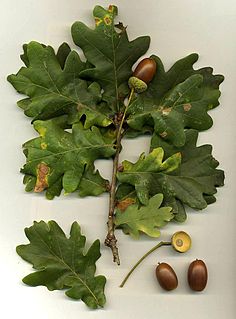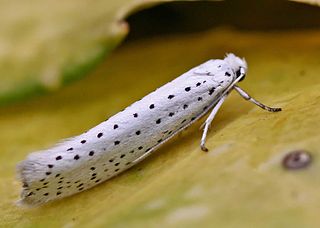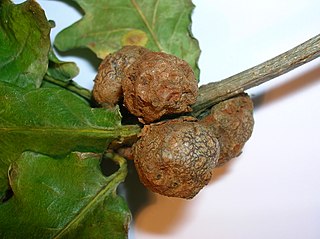
An oak is a tree or shrub in the genus Quercus of the beech family, Fagaceae. There are approximately 500 extant species of oaks. The common name "oak" also appears in the names of species in related genera, notably Lithocarpus, as well as in those of unrelated species such as Grevillea robusta and the Casuarinaceae (she-oaks). The genus Quercus is native to the Northern Hemisphere, and includes deciduous and evergreen species extending from cool temperate to tropical latitudes in the Americas, Asia, Europe, and North Africa. North America contains the largest number of oak species, with approximately 90 occurring in the United States, while Mexico has 160 species of which 109 are endemic. The second greatest center of oak diversity is China, which contains approximately 100 species.

Galls or cecidia are a kind of swelling growth on the external tissues of plants, fungi, or animals. Plant galls are abnormal outgrowths of plant tissues, similar to benign tumors or warts in animals. They can be caused by various parasites, from viruses, fungi and bacteria, to other plants, insects and mites. Plant galls are often highly organized structures so that the cause of the gall can often be determined without the actual agent being identified. This applies particularly to some insect and mite plant galls. The study of plant galls is known as cecidology.

Quercus garryana is an oak tree species of the Pacific Northwest, with a range stretching from southern California to southwestern British Columbia. It is commonly known as the Oregon white oak or Oregon oak in the United States and as the Garry oak in Canada. It grows from sea level to 210 meters (690 ft) altitude in the northern part of its range, and at 300 to 1,800 meters in the south of the range in California. The eponymous Nicholas Garry was deputy governor of the Hudson's Bay Company, 1822–35.

Quercus cerris, the Turkey oak or Austrian oak, is an oak native to south-eastern Europe and Asia Minor. It is the type species of Quercus sect. Cerris, a section of the genus characterised by shoot buds surrounded by soft bristles, bristle-tipped leaf lobes, and acorns that usually mature in 18 months.

The family Yponomeutidae are known as the ermine moths, with several hundred species, most of them in the tropics. The larvae tend to form communal webs, and some are minor pests in agriculture, forestry, and horticulture. Some of the adults are very attractive. Adult moths are minor pollinators.

Iron gall ink is a purple-black or brown-black ink made from iron salts and tannic acids from vegetable sources. It was the standard ink formulation used in Europe for the fourteen-hundred-year period between the 5th and 19th centuries, remained in widespread use well into the 20th century, and is still sold today.

Quercus faginea, the Portuguese oak or Valencian oak, is a species of oak native to the western Mediterranean region in the Iberian Peninsula and the Balearic Islands. Similar trees in the Atlas Mountains of northwest Africa are usually included in this species, or sometimes treated as a distinct species Quercus tlemcenensis. It occurs in mountains from sea level to 1900 m altitude, and flourishes in a variety of soils and climates.

Andricus kollari, also known as the marble gall, is a parthenogenetic species of wasp which causes the formation of marble galls on oak trees. Synonyms for the species include Cynips kollari, Andricus quercusgemmae, A. minor, A. indigenus and A. circulans.

Cola-nut galls develop as a chemically induced distortion of leaf axillary or terminal buds on pedunculate oak or sessile oak trees, caused by the agamic gall wasp Andricus lignicola which lays single eggs within leaf buds using their ovipositor. A previous name or synonym for the species A. lignicola is A. lignicolus and A. venheurni.

Catephia alchymista, the white underwing or alchymist, is a moth in the family Erebidae found in Asia, Europe and North Africa. The species was first described by Michael Denis and Ignaz Schiffermüller in 1775.

Synanthedon decipiens, the oakgall clearwing or oak gall borer, is a moth of the family Sesiidae. It is found in eastern North America.

The Phycitinae are a subfamily of snout moths. Even though the Pyralidae subfamilies are all quite diverse, Phycitinae stand out even by standards of their family: with over 600 genera considered valid and more than 4000 species placed here at present, they unite up more than three-quarters of living snout moth diversity. Together with the closely related Epipaschiinae, they are apparently the most advanced lineage of snout moths.
Vitula lugubrella is a species of snout moth in the genus Vitula. It was described by Émile Louis Ragonot in 1887. It is found in North America, including California.

Adelaide Local Nature Reserve is in North West London, in the area of Chalk Farm, Primrose Hill, Belsize Park and Swiss Cottage. It is managed by a local volunteer group, the Adelaide Nature Reserve Association, which works with the council to improve the site for wildlife and local community use and enjoyment. The site is a Local Nature Reserve and Site of Borough Importance for Nature Conservation, Grade 1.
Oneida is a genus of snout moths. It was described by George Duryea Hulst in 1889.
Oneida grisiella is a species of snout moth in the genus Oneida. It is found in the US state of Texas.
Oneida luniferella is a species of snout moth in the genus Oneida. It was described by George Duryea Hulst in 1895. It is found in the western part of the United States and Mexico.
Oneida marmorata is a species of snout moth in the genus Oneida. It is found in Costa Rica.
Oneida mejona is a species of snout moth in the genus Oneida. It is found in Guatemala and Mexico.
Cydia servillana is a moth of the family Tortricidae which forms galls on the young shoots of willow. It was first described by Philogène Auguste Joseph Duponchel in 1836.













